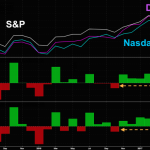The civilian labor force in the U.S. expanded by 806,000 in February and 518,000 in January; both monthly expansions were very steep. The civilian labor force participation rate increased by 0.3 percentage points in February, though it was little changed over the year
The following chart illustrates that the U.S. labor force participation rate has been on a secular decline since the early 2000’s. As the chart illustrates, labor force participation rose slightly in 2017 which permitted faster labor force growth than might have otherwise been expected.
The labor force participation rate (LFPR) is the percentage of working age population that is part of the labor force. That is, the LFPR reflects the proportion of a country’s population that is either employed or actively looking for work. A higher labor force participation rate suggests that more of the country’s population is interested in working.
The labor force participation rate in the United States reached an all time high of 67.3% in January of 2000 and a record low of 58.1% in December of 1954.
What do we know about the new labor force entrants? They may be young and therefore not used to bargaining vigorously on wages. They could also be elderly, attempting to stretch out the value of their retirement savings. Neither new entrant group tends to bargain very vigorously on their wages.
The U.S. Labor Force Participation Rate, 1990-2017












Leave A Comment